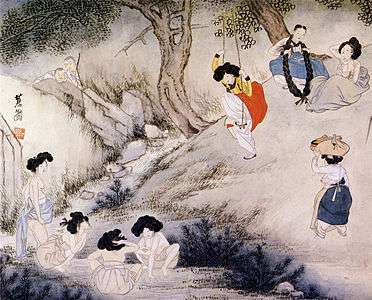Dano (Korean festival)
Dano(Hangul: 단오), also called Surit-nal (Hangul: 수릿날), is a Korean traditional holiday that falls on the 5th day of the fifth month of the lunar Korean calendar. It is an official holiday in North Korea and one of the major traditional holidays in South Korea. South Korea has retained several festivals related to the holiday, one of which is Gangneung Dano Festival (Hangul: 강릉단오제) designated by UNESCO as a "Intangible Cultural Heritage of Humanity".[1]
| Dano | |
|---|---|
 Painting depicting Dano by Shin Yun-bok | |
| Official name | Dano (단오) |
| Also called | Surit-nal (수릿날) |
| Observed by | Koreans |
| Type | Cultural, government |
| Date | 5th day of 5th lunar month |
| Related to | Duanwu Festival Tango no sekku |
| Dano | |
| Hangul | 단오 or 수릿날 |
|---|---|
| Hanja | |
| Revised Romanization | Dano or Surit-nal |
| McCune–Reischauer | Tano or Surit-nal |
In the Mahan confederacy of ancient Korea, this was a day of spiritual rites, and enjoyment with song, dance, and wine. Traditionally, women washed their hair in water boiled with Sweet Flag (changpo (Hangul: 창포)),[2] believed to make one's hair shiny. Women also put Angelica polymorpha (Korean: 궁궁이) flowers in their hair out of the belief that its aroma would repel evil.[3] People wore blue and red clothes and dyed hairpins red with the iris roots. Men wore iris roots around their waist to ward off evil spirits. Herbs wet with dew on this morning were said to heal stomachaches and wounds. Traditional foods include surichitteok, ssuktteok, and other herb rice cakes.[4]
The persisting folk games of Dano are the swing, ssireum (Hangul: 씨름), stone battle game seokjeon and taekkyon (Hangul: 택견). The swing was a game played by women, while ssireum was a wrestling match among men. In addition, mask dance used to be popular among peasants due to its penchant for satirical lyrics flouting local aristocrats.
Etymology


Dano is also called Surit-nal, which means high day or the day of god. The word surit harks back to suri, meaning "wheel," which is why the rice cakes were marked with a wheel pattern.[5]
Origin
Modern historiography tends to characterize Dano to be a shamanistic ritual worshipping the sky deity in celebration of the end of sowing season.[6] According to the article A Comparative Study of the Tano Festivals between Korea and China, the people of Mahan confederacy celebrated day and night with dancing and singing after the sowing season in May. In the ancient state of Jinhan, a rite to heaven was held after the sowing of the seeds in May. It is said this custom was passed on to Silla and was venerated as Dano. In the northern regions living creatures wake from their winter sleep in May, so Dano was originally a holiday celebrated in the northern part of the country.[7] Since the Three Kingdoms of Korea era, the ancestral god also became an object of sacrifice. For example, in Gaya, Dano was one of five annual rituals for Suro, the legendary ancestor of Gaya. Since then, more emphasis was given to the ancestral rituals. Originally called Surit-nal, the new name Dano, derived from the Duanwu Festival, was adopted during Joseon Dynasty along with the exact date of celebration.[6]
See also
- List of Korean traditional festivals
- Public holidays in North Korea
- Traditional Korean holidays
References
- "Festivals of Gangneung". Gangneung City official site. Archived from the original on 2014-01-04.
- Tour2Korea Dano Festival description Archived 2007-10-11 at the Wayback Machine
- "Dano". Korea.net. June 7, 2016. Retrieved June 10, 2020.
- Encyber Encyclopedia article Archived 2008-06-13 at the Wayback Machine
- Festive occasions: the customs in Korea by Sŏ-sŏk Yun
- Park, Jin-Tae. (2008). A Comparative Study of the Tano Festivals between Korea and China. 비교민속학, 37.
- Festive occasions: the customs in Korea by Sŏ-sŏk Yun
The Academy of Korean Studies, ed. (1991), "Dano of May", Encyclopedia of Korean People and Culture, Woongjin (in Korean)